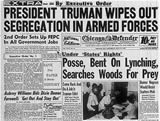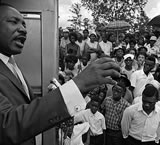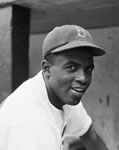 |
 |
|
|
Although Congress didn't respond to the needs of Black Americans after WWII, President Truman and the Supreme Court initiated government action. The era saw the integration of most professional sports, yet whites continued to enforce the status quo through violence, especially over voting rights in the South
|
|
|
| |
 |
|
|
The civil rights movement gained momentum and national attention with Brown v. Board, Rosa Parks & the Montgomery Bus Boycott, and the rise of a charismatic young preacher named Martin Luther King, Jr. Yet even as the U.S. Army was used to force school integration, violence against blacks remained prevalent, and most Southern politicians remained defiant and obstructive
|
|
|
| |
 |
|
|
The postwar era saw the integration of America's professional sports. Jackie Robinson, Althea Gibson, Bill Willis and others became household names. It was also the era of anti-Communism inquisitions, and black writers and performers were investigated for having expressed sympathy for an ideology that did not tolerate racism. Meanwhile, black recording artists captivated America's youth
|
|
|
| |
|

|
|
|
|
|
|
|
|
|
|

